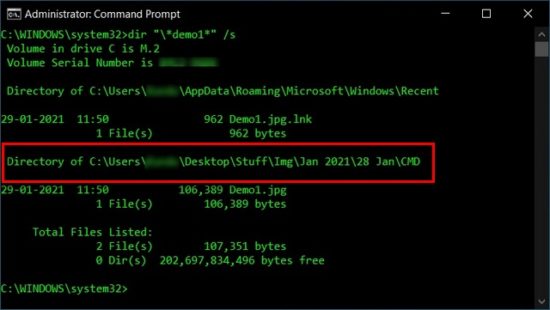

- #Windows find file command line how to
- #Windows find file command line pdf
- #Windows find file command line zip file
- #Windows find file command line serial
- #Windows find file command line driver
$folders = ($file in (Get-ChildItem $path -Force -ea Silentl圜ontinue)) The path parameter specifies the search root, and the first parameter determines how many folders will be returned. The script uses two command line parameters: path and first that you can either modify directly or change from the command line. The below PowerShell script is prepared from “Hey Scripting Guy” at. Method 3: Find large files on windows using Powershell

#Windows find file command line zip file
If you want to learn more about using the commands, the windows command line cheat sheet would be a great resource. Whether you're a beginner or an experienced user, the sheet can help you get the most out of your windows experience.READ ALSO - Batch Script to zip file using CMD batch file Windows command line can be extremely useful for any Windows user. Start a new instance of the command interpreter.Ĭhange the foreground and background colors in the Command Prompt window for the current session.ĭisplay a list of the available commands.
#Windows find file command line driver
System Information & Configuration Commandsĭisplay device driver status and properties. View the computer name and the IP address of an endpoint computer.ĭetermine the route to a destination by sending ICMP packets to the destination.

#Windows find file command line serial
Recover readable information from a bad or defective disk.ĭisplay the disk volume label and serial number.ĭisplay and modify entries in the ARP cache.Ĭreate, download or upload jobs and monitor their progress.ĭisplay and modify information about the routing tables used by the IPX protocol.Ĭonnect/disconnect a computer to/from a shared resource Perform tasks that related to FAT and NTFS file systems.Ĭreate, change, or delete the volume label of a disk. Start or stop disk performance counters for Performance Monitor.Ĭheck to see if the specified amount of disk space is available before continuing with an installation process. Locates and consolidates fragmented files on local volumes.ĭisplay information about the selected disk.Ĭompare the contents of two floppy disks. Remove all partitions or volume formatting from the disk with focus.Ĭonvert a disk from one disk type to another. Replace existing or add new files to a directory.Ĭopy file data from one location to another.ĭisplay or modify automatic disk checking when the computer is started. Move files from one directory to another.ĭisplay the current open files list or disconnect opened files/folders. Or you can view the online sheet below, and start making the most of the command line! Simply print it out or keep it open on your desktop, and you'll always have the information you need right at your fingertips.
#Windows find file command line pdf
Our windows command line cheat sheet pdf provides a handy reference guide to all the most commonly used commands. There are so many different commands and options, and it can be difficult to know where to start. If you're new to the Windows command line, you may be feeling a bit overwhelmed.
#Windows find file command line how to
Now that you know how to open command prompt in Windows, you can use it to run various commands to perform tasks on your computer. From here, you can type any commands you wish to execute.Īlternatively, you can also press the "Windows key + R" on your keyboard. This will open the Windows Command Prompt. Then, type "cmd" into the search box and press Enter. First, open the Start menu by clicking the Start button or pressing the Windows key. Opening the command line in Windows is a simple process. With a bit of practice, you can quickly learn how to use the windows command prompt to manage your computer more efficiently. While the command line may seem daunting at first, it's actually quite easy to use. You can perform all sorts of tasks using the command line, from launching programs to accessing system settings. Often referred to as the "command prompt" or simply "prompt," the command line provides a text-based interface for issuing commands and controlling your computer.

The windows command line is a text-based interface that allows you to execute commands on your computer. This article will guide you on opening the Windows command prompt and provide you with the Windows command line cheat sheet. From basic tasks like managing files and directories to more advanced tasks like scripting and automation, the command line can help you do just about anything. The Windows command line is a powerful tool that can be used for a variety of tasks. PAGE CONTENT: What is Windows command line? How do I open a command line in Windows? Windows Command Line Cheat Sheet Files & Folders Comands Disk & Partition Commands Network Commands System Information & Configuration Commands Command Line Setup Commands Conclusion


 0 kommentar(er)
0 kommentar(er)
